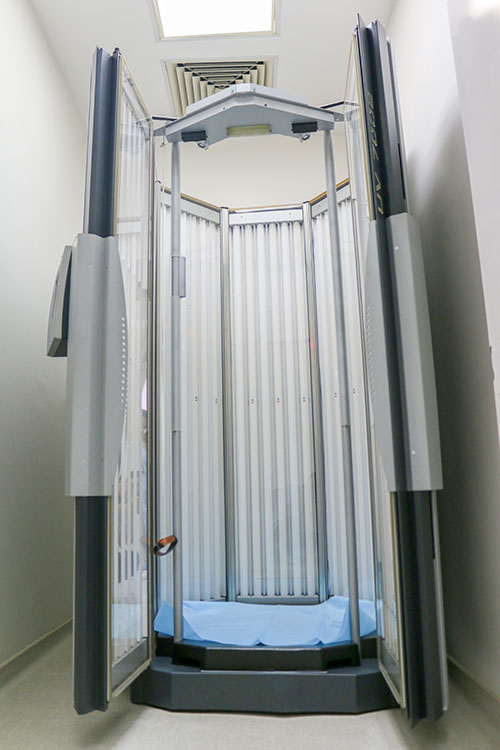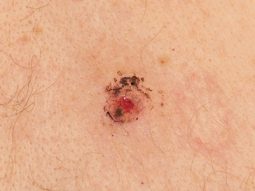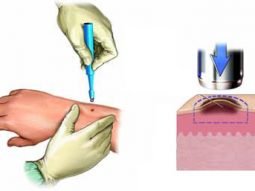What is PUVA treatment?
Ultraviolet (UV) rays are produced by the sun and are grouped into different wavelengths. Ultraviolet light A (UVA) is one of the wavelengths that have been found to be useful in treating certain skin conditions. PUVA is a combination of a drug called Psoralen (P) and ultraviolet light A (UVA), hence the term PUVA.
Psoralens are chemicals that are photosensitising, this means that they make us more sensitive to sunlight. After the skin has been sensitised with the psoralen, UVA treatment is given by standing in a cabinet where the whole body is exposed to UVA.
PUVA treatment must be carried out in the hospital under medical supervision, 2 to 3 times a week, on non-consecutive days, for usually seven to ten weeks.

What conditions are treated with PUVA?
PUVA treatment can be indicated for various skin conditions, the most common is psoriasis but it can also be helpful in other conditions such as mycosis fungoides, solar urticaria, chronic actinic dermatitis, and others.
What are the potential side-effects of PUVA treatment?
- Queasiness after taking the psoralen tablets.
- Sunburn-like reaction (either due to individual hypersensitivity or to the concomitant intake of a medication that increases photosensitivity).
- Itchy skin.
- Very rarely a prickling sensation of the skin, occasionally bad enough to necessitate stopping treatment.
Skin dryness (this can easily be helped with moisturising creams). - PUVA treatment leads to tanning of the skin. This will fade over a few months after finishing treatment.
- The importance of wearing special goggles during the sessions and protective UV glasses for the rest of the day after taking the tablets cannot be underestimated as there is a risk of cataract damage to the lens in the eyes.
- Premature ageing changes in the skin (e.g. dryness, freckling and wrinkling) may occur in patients who have had multiple courses of PUVA therapy for many years and such they may have a slightly increased risk of developing skin cancer in later life. Your doctor will have assessed your skin type already and discussed this as part of your consent process. Safe lifetime doses are monitored in the department.
- Rashes: be aware that your skin condition could temporarily worsen during treatment. Very occasionally patients develop an itchy, bumpy rash during the course of treatment known as polymorphic light eruption. If this happens we may alter your treatment to allow this to settle.
- PUVA treatment during pregnancy: there is no evidence that PUVA can harm an unborn baby. However, if pregnancy is suspected at any point during the course, the treatment will be stopped until your baby is born. PUVA treatment is also not advised during breastfeeding.
What precautions should be taken?
Before treatment
- Please take the prescribed number of tablets two hours before attending the department for treatment. To reduce nausea, capsules should be taken with food or milk. Avoid furocoumarin-containing foods (limes, figs, parsley, celery, cloves, lemon, mustard, carrots) because they may make your skin more sensitive to the ultraviolet light.
- Protective UV sunglasses must be worn for 12 hours after you have taken your tablets if outdoors or inside near any fluorescent lighting.
- Do not apply perfumes, deodorants, aftershave lotions, other cosmetic products, creams or ointments to your skin within a few hours before your treatment as these may make your skin more sensitive to the ultraviolet light.
- Do not drink alcohol.
- Tell your doctor or nurse if you have been taking any new medication and if you have developed excessive discomfort or redness of the skin following treatment.
During treatment
- Psoralen tablets make both the skin and eyes sensitive to light for some hours. It is therefore most important that you wear the protective goggles, which are provided, during each treatment.
- The lips should be covered with a sun block prior to PUVA treatment.
- If you have spots on your scalp that need treatment, cut your hair as short as possible. If impossible, use hairpins to expose the spots for treatment.
- If you don’t have spots on the face or the neck, protect these areas with a scarf and sunblock cream.
- It is important that clothing is not worn whilst undergoing treatment in the light cubicle (except male patients, who will need to wear a protective covering to the genital area).
- Stay in the middle of the treatment cabin and do not move around during treatment.
After treatment
- Do not take any new medication without asking your dermatologist if they can be taken without risk during PUVA treatment.
- Throughout the course of your treatment, you should not sunbathe or use a sun bed at any time.
- Do keep your skin covered and use a high Sun Protection Factor (SPF) sunscreen on exposed skin (such as face and hands) when you are outside or when you are exposed to sunlight through window glass.
- Remember that UVA light is still present on a cloudy day. It also penetrates through window glass such as in a car.
- Do not have a haircut during the whole course of your treatment, except if you have spots on your scalp that need treatment. This is to prevent burning of areas which were previously covered by hair, such as your neck, forehead or ears.
- For treatment to be effective, it is important to attend the hospital regularly. If you are unable to attend for treatment, yourself or a relative should inform the medical secretary. PUVA treatment results can take a while to appear. Most people will see improvement only after 10-20 treatments.

 Vi
Vi 












